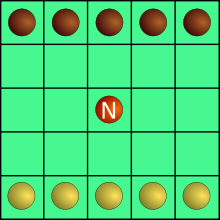Neutron (game)
Neutron is a two-player abstract strategy game invented by Robert A. Kraus. The game was first published in the Playroom section of Games & Puzzles 71 in July/August 1978. It is a game where each player moves two different pieces in a single turn without the use of dice.

There are 15 variants to this game. Neutron and some of its variants are some of the main games featured in Zillions of Games.
The game has been solved to some degree. Analysis has shown that the first player wins. It is unknown whether the other variants have been solved or not, and to what degree.
Goal
The goal of each player is to bring the Neutron to their home rank (the first rank on their side of the board). The player can either bring the Neutron to their home rank during their turn, or have the other player bring it over there which only normally happens if forced upon during their turn. The other way to win, is to stalemate the other player, that is, by not allowing the other player complete their turn which consist of moving the Neutron first, and then one of their soldiers (except on the first player's first turn where they can only move a soldier).
Equipment
It is normally played on a 5 x 5 board. There are 15 variants to this game, and the size of the board may change. Each player has five soldiers. There is also a neutral piece called the Neutron that is played by both players.
Rules and Game Play
- The game starts with five white pieces on White's home row (one edge of the board), five black pieces on Black's home row, and the neutron in the center.
- All pieces move in a straight line horizontally, vertically, or diagonally, but they must move as far as they can go in the chosen direction. They can only move through or onto empty squares and there is no capturing.
- Play begins with one player moving a piece from the home row. Thereafter on each turn, a player moves first the neutron and then one of his or her pieces.
- The object of the game is to move the neutron into your home row, cause your opponent to move the neutron into your home row, or to block the neutron completely so your opponent can't move it.